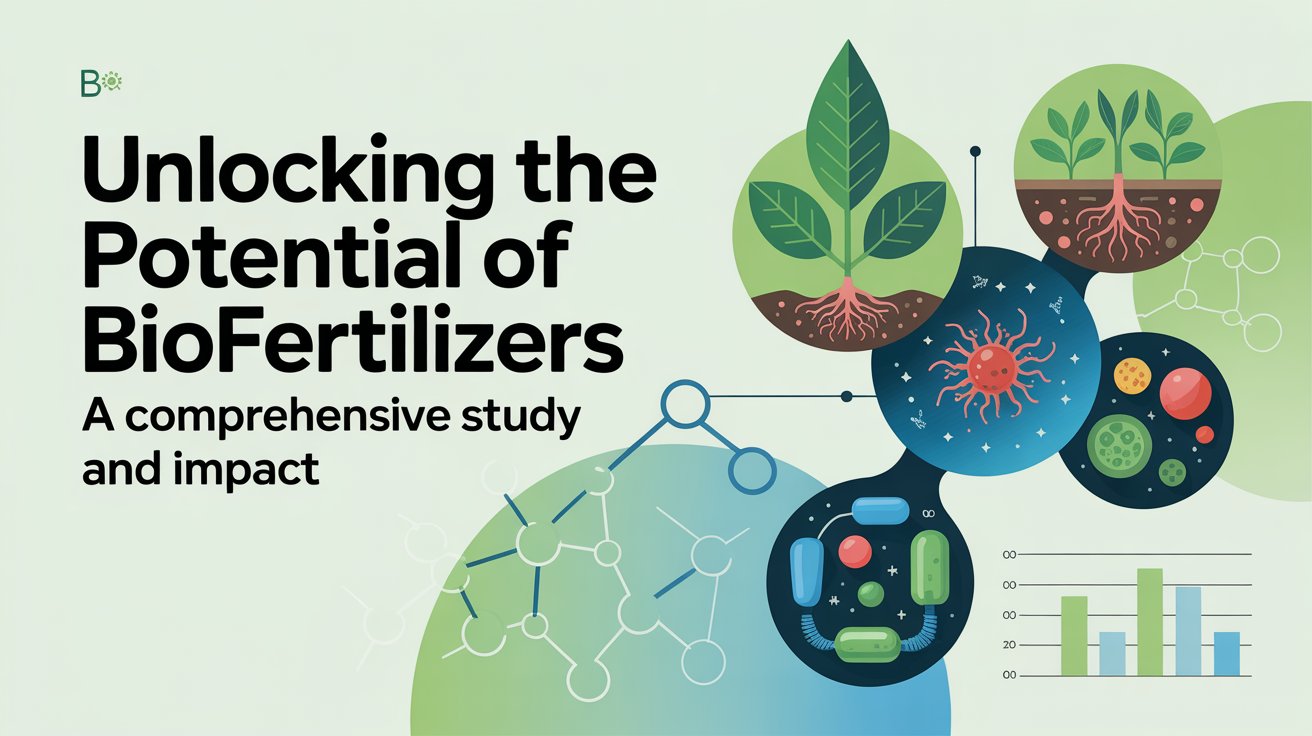BIOFERTILIZER are natural microbial inoculants used to improve soil fertility and aid plant growth sustainably. The action biofertilizer products increase helpful bacteria, fungi, and other types of microbes in the soil to assist movement of nutrients, boost root growth and enhance crop yields. Recent biofertilizers study and effects indicate that using biofertilizer products long term can reduce chemical fertilizer use, enhance soil quality, and facilitate agriculture sustainability.
Liquid biofertilizer products are becoming a popular bioformulation due to ease of applications and faster colonization of microbes. Liquid biofertilizer allows even distribution of microorganisms using seed treatments, soil applications or foliar application thus allowing the microbes to work quicker in establishing colonies in the root zone, better roots, higher health, more nutrient acquisition and improved environmental resilience.
The biofertilizers study and effects also identified economic and environmentally sustainable practices. Farmers using BIOFERTILIZER reported greater yields, improved plant health and better longevity and fertility of soil. Using liquid biofertilizer with an integrated nutrient management program supports sustainability and eco-friendly practices in agriculture.
Introduction: Understanding Biofertilizers and Their Role in Agriculture
Biofertilizers are natural products containing live microorganisms to improve availability of nutrients essential for plant uptake. It represents a more ecological option to synthetic fertilizers to support agricultural productivity while preserving soil health.
Key Points:
- Definitions: A BIOFERTILIZER is derived from products that contain beneficial microbes, such as nitrogen-fixing bacteria, phosphate-solubilizers, and potassium-mobilizing microbes.
- Function: Once introduced to plants, biofertilizers allow the microbes to colonize plant roots and in the rhizosphere, converting nutrients from the media to a plant-available form.
- Sustainable Impact: Less use of chemical fertilizers means biofertilizers can support sustainable farming practices and improve environmental and soil degradation.
Benefits in Agriculture:
- Soil health improvement: Improves microbial diversity, organic matter, and nutrient cycling in impoverished soils.
- Costs associated with farming: Less reliance on expensive chemical fertilizers that may or may not contribute to improving crop yields.
- Faster nutrient uptake with liquid biofertilizer: Liquid formulations maintain higher microbial viability for quicker root colonization than solid forms of biofertilizers.
What Are Biofertilizers and How Do They Work
- Definition: BIOFERTILIZER is a natural product made up of living microorganisms that are beneficial because they make nutrients more readily available in the soil
- Mechanism: The microorganisms can fix gaseous nitrogen, solubilize phosphorus, and mobilize potassium to enhance cropping
- Benefits: Improves soil fertility; decreases reliance on chemical fertilizers, and improves plant health, in an environmentally sustainable way.
Biofertilizers work by colonizing the rhizosphere and the roots of the plants and impacting nutrient uptake, enhancing soil structure and ultimately protecting long-term productivity. Biofertilizers are a key element of sustainable agriculture.
Importance of Biofertilizers for Sustainable Agriculture
- Environmental Friendly Practices: Minimized dependency on chemical fertilizers and pollution caused to the environment.
- Soil Health: Increases diversity, organic matter, and a cycle for nutrients.
- Cost-Effective: Reduced cost of inputs in the long-term of farming systems despite an increase in crop yield.
Biofertilizers in farming systems stress sustainable agriculture practice by supporting the availability of nutrients and enhancing soil quality and crop resilience.
Overview of Biofertilizers Study and Impact
- Scientific Research: Research has shown through studies on biofertilizers that there is an increase in crop yield, increased uptake of nutrients and increased microbial activity in soil.
- Liquid Biofertilizer Benefit: Liquid formulations allow for faster colonisation of the plant's roots and increased microbial levels than solid biofertilizers.
- Globalization: Broad adoption of biofertilizers in the modern farming systems has lead to evidence in cereals, pulses, oilseeds and horticultural crops.
The Science Behind Biofertilizers: Mechanisms and Benefits
To appreciate BIOFERTILIZER'S role in sustainable agriculture, it is important to understand how BIOFERTILIZER operates. Biofertilizers depend on living microorganisms to render certain nutrients more available to plants, in order to represent higher production, improved growth, and improved soil conditions. Research on the impacts and benefits of biofertilizers studies has consistently shown measurable benefits, to crops, in multiple agro-climatic conditions.
Biological Nitrogen Fixation and Soil Enrichment
- Some bacteria, such as Rhizobium and Azotobacter, can fix nitrogen from the atmosphere into ammonia that plants can use.
- Increases the nitrogen levels in soil without chemical input, which can help alleviate synthetic fertilizers.
- Increases long-term soil fertility through increased organic matter and different populations of soil microbes.
Phosphorus and Potassium Solubilization by Microbes
- Microbes such as Bacillus and Pseudomonas can solubilize phosphorus and potassium, making them available for uptake by plants.
- Enhancing nutrient uptake efficiency in plants can lead to greater growth and increased yield.
- I'm sure it delivers lower nutrient losses and reduced environmental pollution when compared to traditional fertilizers.
Role of Liquid Biofertilizer in Enhancing Microbial Activity
- Liquid biofertilizers provide an adequate medium for microbial survival and fast colonization to plant roots.
- It is more effective a more rapid uptake of nutrients and a more even application than a granular form.
- Increases plant microbial activity in the rhizosphere and can increase plant tolerance to stress and improve yield.
Positive Effects of Biofertilizers on Crop Yield and Quality
The application of BIOFERTILIZER has shown positive, measurable impacts on crop yield and quality across different agricultural systems. Assessment of biofertilizers' use and impact shows that applying these beneficial microbes to crop management enhances nutrient uptake while also promoting plant resilience, which ultimately leads to improved marketable crop products. Liquid bioforms enhance microbial colonization speed, as well as provide an even distribution of application which increases effectiveness.
Increased Nutrient Uptake and Crop Productivity
- The beneficial microbes that comprise BIOFERTILIZER function to fix atmospheric nitrogen and solubilize phosphorus and potassium to a form that is readily taken up by plants.
- Better nutrient availability equals stronger root structure and more robust vegetative plant growth.
- Field trials have repeatedly shown that applying biofertilizers will lead to higher yields of cereals, pulses, and vegetables where the products are blended with conventional practices.
Enhanced Resistance to Biotic and Abiotic Stress
- Biofertilizers foster beneficial soil microbiomes that inhibit pathogens and mitigate disease risk.
- Induce systemic tolerance in plants to drought, salinity, and temperature extremes.
- The fast-acting microbial response stimulated by a liquid biofertilizer enhances the ability of crops to survive stressful situations.
Improvement in Crop Quality and Market Value
- Crops treated with biofertilizers generally have greater protein content, larger grain size, and improved nutritional profile.
- Fruits and vegetables treated with biofertilizers have improved shelf-life, color, and taste which increases marketability.
- Less chemical applications lead to organic certification and environmentally friendly brand identity, which increases economic return for farmers.
Comparative Analysis: Biofertilizers vs. Chemical Fertilizers
Deciding to use BIOFERTILIZER or fertilized products is a major key to sustainable agriculture. Biofertilizer research and documentation of side effects may suggest that biofertilizers (including liquid biofertilizer formulations) will support soil health, environmental sustainability and farm economic viability for a much longer time period, than chemical fertilizers' timely nutrient provision of chemical fertilizers will stress ecosystems upon excess application.
Environmental Impact: Reduced Pollution and Sustainability
- BIOFERTILIZER improves natural nutrient cycling, thus reducing chemicals available to contaminate waterways.
- Contributes to beneficial microbial activity in soil, shifting from chemical fertilizer applications, and movement towards ecosystem sustainability.
- Liquid bio-fertilizer can even out nutrient distribution in liquid waste products and lower carbon footprint accordingly.
- Chemical fertilizers can be productive in terms of timely nutrient supply; however, they are associated with water contamination, soil acidification, and greenhouse gas emissions, when poorly managed.
Long-Term Soil Fertility vs. Short-Term Nutrient Boost
- Biofertilizers promote long-term soil fertility by improving soil microbial populations and organic matter content in soils.
- Longer-term delivery of nutrients means that crops can be grown over more than one season, rather than over the course of one or two weeks.
- Chemical fertilizers is a short-term nutrient supply, can be costly and often needs reapplication, leading to less healthy soil overall for extended time.
- Liquid biofertilizer increases nutrient availability and improves soil structure, making it a better option than heavy applications of chemical fertilizers that compact soil over time.
Economic Benefits and Cost-Effectiveness of Biofertilizers
- Using BIOFERTILIZER provides a less costly option to lessen reliance on more expensive chemical fertilizers.
- Liquid biofertilizers in formulations are readily transportable, safe to store and handle while saving time to apply, reducing some labor and running costs.
- Over time, improvements in crop stability in yield and quality in marketable products leads to increased profits due to long-term adoption.
- Research indicated that uvificando biofertilizer models impact on crop management is cost savings and improved efficiencies as complementary to better more sustainable agricultural practices.
FAQs
Q1 What are biofertilizers and how do they work?
Biofertilizers are natural microbial products that enhance soil nutrients and improve plant development. Biofertilizers function by nitrogen fixation, phosphorus solubilization and increasing soil fertility.
Q2 How do biofertilizers improve crop yield?
By enhancing nutrient availability and enhancing beneficial microbial functioning, BIOFERTILIZER is said to promote stronger plant development resulting in increased yield.
Q3 What is the role of liquid biofertilizer in agriculture?
Liquid biofertilizer provides for easy application, rapid microbial colonization and variable uniformity to crops.
Q4 Can biofertilizers completely replace chemical fertilizers?
While biofertilizers reduce the reliance on chemical fertilizers, all forms of chemistry are not likely to be fully replaced in all farming systems. The recommended use of biofertilizers is in conjunction with chemical fertilizers in the practices of sustainable agriculture.
Q5 How should biofertilizers be stored to maintain effectiveness?
BIOFERTILIZER should be stored in a cool, dry place away from sunlight in containers that remove all air from the biofertilizer to maintain viable microbes and lengthen biosystem life.
Q6 What have studies shown about the impact of biofertilizers?
There is a significant amount of research that confirms the benefits to soil fertility, the benefits to crop yield, and the benefits to sustainability through traditional biofertilizers, in a variety of reports.
Q7 Are liquid biofertilizers more effective than solid forms?
Liquid biofertilizer generally acts more quickly and helps to ensure uniform application, leading to more efficacy on crops and soil health.
Conclusion: Embracing Biofertilizers for a Sustainable Future
The use of BIOFERTILIZER technology is a major step toward sustainable agricultural development. By utilizing bio-based fertilizers, farmers can improve fertility, lessen reliance on agro-chemicals, and promote sustainable crop production in the long term.
The value of biofertilizers and their effects really emerge in their ability through continued use to facilitate nutrient up-take in crops and improve the resistance of plants to biotic and abiotic stresses. In this way, biofertilizers promote more environmentally sustainable, financially viable and sustainable agricultural practices.
In addition, liquid biofertilizers can also help farmers quickly colonize microbes in plants, improve application, and distribute nutrients across a wide range of fields, which work to maximize the intrinsic nature of bio-based fertilizers. Using biofertilizers helps farmers secure higher yields, maintains the health of their soils, and means they can farm in a more sustainable and resilient manner through an environmentally green, biological input.




